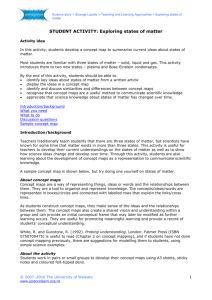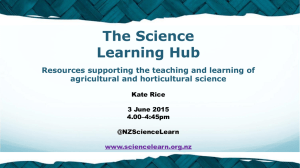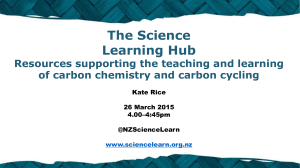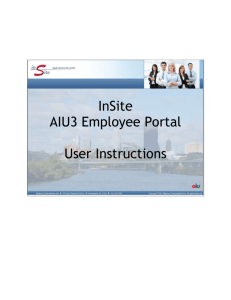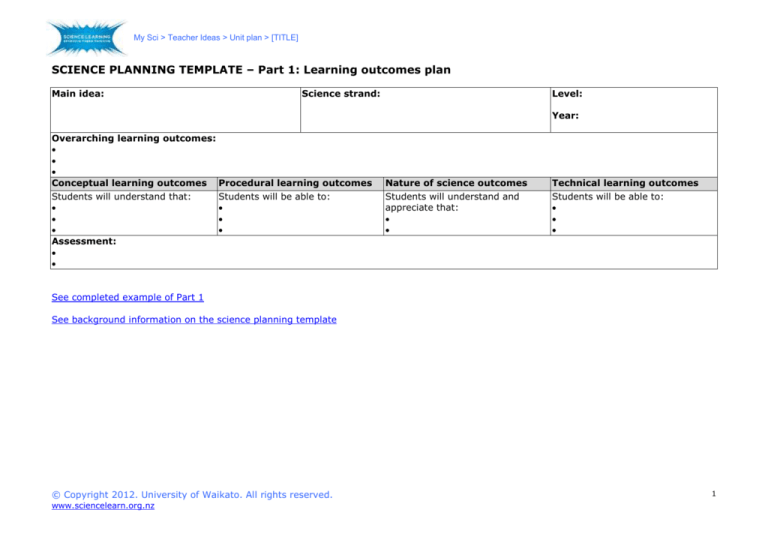
My Sci > Teacher Ideas > Unit plan > [TITLE]
SCIENCE PLANNING TEMPLATE – Part 1: Learning outcomes plan
Main idea:
Science strand:
Level:
Year:
Overarching learning outcomes:
Conceptual learning outcomes Procedural learning outcomes
Students will understand that:
Students will be able to:
Assessment:
Nature of science outcomes
Students will understand and
appreciate that:
Technical learning outcomes
Students will be able to:
See completed example of Part 1
See background information on the science planning template
© Copyright 2012. University of Waikato. All rights reserved.
www.sciencelearn.org.nz
1
My Sci > Teacher Ideas > Unit plan > [TITLE]
SCIENCE PLANNING TEMPLATE – Part 2: Lesson plan
Main idea:
Subtasks
Meso tasks
Day 1
Micro tasks
1.1
1.2
1.3
Day 2
2.1
2.2
2.3
Day 3
3.1
3.2
3.3
Day 4
4.1
4.2
4.3
Day 5
5.1
5.2
5.3
Resources/focal artefacts
Planned interactions
Key student outcomes
© Copyright 2012. University of Waikato. All rights reserved.
www.sciencelearn.org.nz
2
My Sci > Teacher Ideas > Unit plan > [TITLE]
SCIENCE PLANNING TEMPLATE – Part 1: Learning outcomes plan
Main idea:
The big science idea for students to understand, for example:
Sound is comprised of waves.
Fossils provide clues to the past.
Moulds are a type of fungus and are living.
Overarching learning outcomes:
Science strand:
Level:
Year:
Derived from and relating to the main idea, teased out in more detail. They show science as a holistic practice where ideas and skills come together so that the main idea can be
understood. These are usually broad statements covering scientific knowledge, practice and nature of science outcomes. Here are two examples:
In building understandings about sound, students will integrate:
understandings that properties of sound relate to the manner in which sound waves travel through a substance (scientific knowledge)
an investigation into how musical instruments generate sound waves (scientific practice)
understandings that scientific knowledge can be used to help people (nature of science).
In building understandings about adaptation, students will integrate:
understandings about how the features of an animal living on the rocky shore have allowed it to adapt to its particular habitat (scientific
knowledge)
an investigation of how a local ecosystem fosters the interdependence of living organisms, including humans, and their relationship with their
physical environment (scientific practice)
understanding that the nature of experimentation can include making predictions, observing, recording results and drawing conclusions
(nature of science).
Conceptual learning outcomes
Procedural learning outcomes Nature of science outcomes
Technical learning outcomes
Focused on knowledge and understanding of Focused on strategic application of
relevant scientific concepts and procedures, procedures and processes, such as used in
for example:
science investigations, for example:
Students will understand that:
mould colonies reproduce and
grow where the conditions meet
their needs
beach ecosystems are a balance
of living and nonliving elements,
that interact with each other
sound travels as a wave,
producing vibrations.
Students will be able to:
classify living things
generate and identify questions
that are suitable for an
investigation
confidently make predictions
about direction of movement
carry out a procedure by
following a sequence of simple
steps
record results appropriately.
Related to what counts as evidence and
methods appropriate for communication of
scientific ideas, for example:
Students will understand and
appreciate that scientists:
make categories so they can
understand what they see
make predictions then test them
use observation and describe
what they see
change their ideas over time as
they find and make sense of new
fossil discoveries.
Assessment:
For example: Poster, investigation report, before and after views, Short test
© Copyright 2012. University of Waikato. All rights reserved.
www.sciencelearn.org.nz
Related to practical techniques and
equipment use, for example:
Students will be able to:
label observational drawings
label test equipment
develop technical skills for
cutting, threading, knotting
connect components of a circuit
to make a working circuit.
3
My Sci > Teacher Ideas > Unit plan > [TITLE]
Background information on the science planning template
Teaching science to primary school students is not simple. Teachers need to be able to take
science concepts and present them in ways that enable students to learn.
The two-part science planning template can help teachers move from simply planning activities
for students to do, to planning what and how students will learn through a coherent series of
lessons.
This is not to suggest that planning should set the day in stone. The wonderful thing
about planning is that once you’ve done it, you can make all kinds of changes and
adjustments and not lose the plot. Or, if you do it’s on purpose. (Earl, 2003)
The planning template
The science planning template was devised by teachers and researchers involved in the InSiTE
project (Cowie, Moreland, Jones & Otrel-Cass, 2008). The project explored teaching and
learning in science and technology in primary classrooms.
There are two parts to the planner:
Part 1 is the focusing inquiry and outlines the scope of what is important to learn.
Part 2 is the teaching inquiry helps teachers plan the pedagogical approaches and
strategies that will help students learn the ideas and skills specified in Part 1. Completing
Part 2 focuses the teacher on planning learning opportunities aimed at achieving the
outcomes they have prioritised. There are spaces to record a sequence of subtasks that
contribute towards achieving the main task, resources required for each subtask, the
interaction focus for each subtask and possible student outcomes and responses.
More information and references
For best results, you may need to use the Google Chrome browser when following the links
below on the Teaching & Learning Research Initiative (TLRI) website.
For a more comprehensive understanding of both parts of the planning template, see The
Classroom InSiTE Project: Understanding classroom interactions to enhance teaching and
learning in science and technology in Years 1–8 and click on the ‘Insite Planning’ link at the
bottom of the page.
Cowie, B., Moreland, J., Jones, A., & Otrel-Cass, K. (2008). The classroom InSiTE project:
Understanding classroom interactions to enhance teaching and learning in science and
technology in Years 1–8. Wellington: Teaching and Learning Research Initiative.
http://www.tlri.org.nz/sites/default/files/projects/9215_finalreport_0.pdf (1.45 MB)
Earl, L.M. (2003). Assessment as learning: Using classroom assessment to maximize student
learning. Thousand Oaks, CA: Corwin Press.
Moreland, J., Cowie, B., Otrel-Cass, K., & Jones, A. (2010). Planning for learning: Building
knowledge for teaching primary science and technology. Wellington: Teaching and Learning
Research Initiative. http://www.tlri.org.nz/sites/default/files/projects/InsitePlanning.pdf
(555 KB)
© Copyright 2012. University of Waikato. All rights reserved.
www.sciencelearn.org.nz
4








